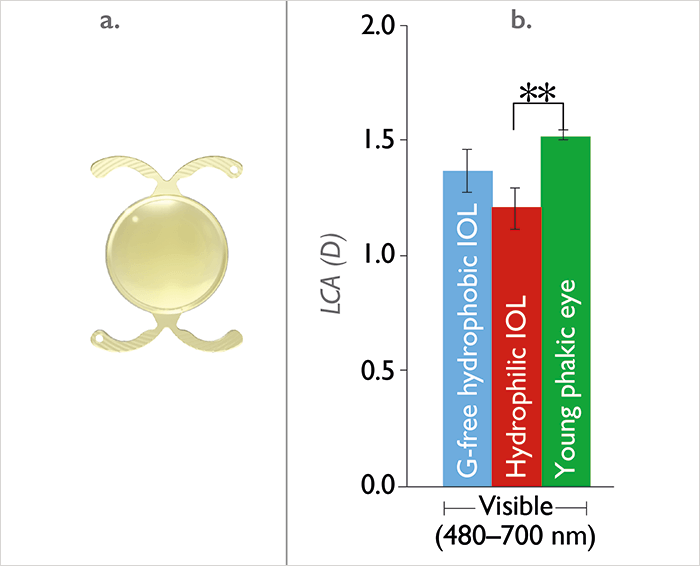
We live in a polychromatic world, yet most optical quality assessments are monochromatic (with most being performed with infrared light). Learning about color – and chromatic aberration – is important, and I want to explain what this means for IOL materials. Longitudinal chromatic aberration (LCA) occurs in the eye because of the wavelength dependence of the refractive index of ocular media. LCA makes short wavelengths focus in front of long wavelengths – in other words, we are myopic for blue, and hypermetropic for red. But when we replace the crystalline lens with an IOL, the chromatic dispersion of the ocular media changes – and this might be different for different IOL materials. We set out to characterize this.
One commonly performed IOL optics assessment is the assessment of the lens’ modulation transfer function (MTF). In essence, MTF describes contrast as a function of spatial frequency, and you can think of it a measure of optical contrast sensitivity: the higher the MTF, the higher the contrast of the images projected on to the retina. If you have a perfect, aberration-free eye and you measure the MTF for red and green, then both are actually very high, but the MTF for blue is highly degraded. Why? Chromatic defocus – thanks to LCA. However, when you compare a real eye (with real aberrations) to a theoretical “perfect” eye, the red and green MTFs are much poorer, thanks to the effects of monochromatic aberrations, but the MTF is much better with blue (1). Again, why? The chromatic and monochromatic aberrations have actually interacted to improve the blue MTF. You could take the view that chromatic aberrations protect from higher order aberrations (or vice versa), but the take-home message is that to get a true understanding of lens performance, you need to understand all the interactions, both monochromatic and chromatic, so you need to measure both. Conventional aberrometers usually employ one wavelength, almost always in the infrared spectrum. We have a sophisticated system that combines adaptive optics, a supercontinuum laser source that can operate at many different wavelengths (from 480–950 nm), a Hartmann-Shack wavefront sensor to measure aberrations and defocus across those wavelengths, and a psychophysical channel that we can illuminate with the same laser light to measure best focus across the visible light spectrum (480–700 nm). We used this system to assess both objective and psychophysical LCA across the visible spectrum (and perform wavefront detection across the visible and infrared spectra) in 18 eyes from 9 patients. These patients were bilaterally implanted with aspheric PhysIOL monofocal IOLs of the same double C-loop design (Figure 1a), but made from different materials. One eye received the G-free (patented by PhysIOL) hydrophobic acrylic lens, the other, the hydrophilic acrylic lens. We obtained chromatic difference-of-focus curves from best-focus data at each wavelength, enabling us to calculate the LCA from the slope of linear regressions of those curves.
What did we find and what does it mean?
The eyes implanted with the hydrophobic G-free IOL had a small but consistently higher LCA than the eyes implanted with the hydrophilic IOL; we found a statistically significant difference of 0.16 and 0.15 D when measured by psychophysical and wavefront-sensing methods, respectively, in the visible light wavelength range. And things get interesting when we start to compare these results with those of young phakic eyes – see Figure 1b. In terms of LCA, the hydrophobic G-free material appears to mimic the natural lens – the values are very close, and that’s true irrespective of whether we measure LCA psychophysically or with the wavefront sensor, and it’s also irrespective of the wavelength range examined. Remember, chromatic aberrations play a major role in the quality of vision, and LCA interacts with the eye’s natural aberrations to improve the overall quality of vision. I think it’s important to keep the LCA balance that’s present with the crystalline lens, and I think that’s what we achieve with this hydrophobic G-free material.Susana Marcos is Professor and Director of Visual Optics and Biophotonics Lab at the Instituto de Óptica, Consejo Superior de Investigaciones Científicas, Madrid, Spain.
References
- JS McLellan et al., “Imperfect optics may be the eye’s defence against chromatic blur”, Nature, 417, 174–176 (2012). PMID: 12000960. M Vinas et al., “In vivo subjective and objective longitudinal chromatic aberration after bilateral implantation of the same design of hydrophobic and hydrophilic intraocular lenses”, J Cataract Refract Surg. 41, 2115– 2224 (2015). PMID: 26703287.
